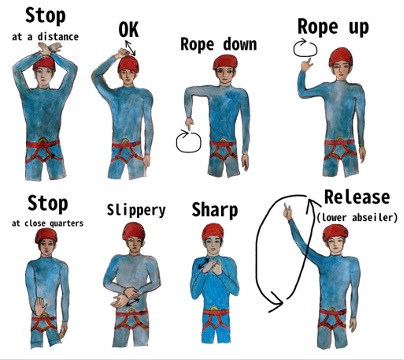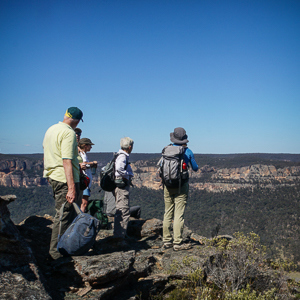Guidelines for Canyoners
Guidelines for Canyoners
Technical canyoning is physically and mentally demanding and may involve: carrying heavy gear whilst walking off-track in rugged terrain with steep climbs and descents; swimming and wading in deep, cold, creeks, pools, and fast-moving water; encounters with escarpments, exposed cliff-lines, open face waterfalls, narrow gorges, tunnels, passages and cave-like formations. Rappelling, also known as abseiling, is the act of descending a rope or pair of ropes in a controlled way. Refer to UBMBC Canyoning Program document for information about the program.
Joining the Canyoning Program
All members intending to join the UBMBC canyoning program must complete a creek walk with UBMBC.
Members who are new to canyoning must also complete an abseil training course with an accredited commercial training provider. After completing this, members should apply to the UBMBC canyoning subcommittee (canyoning@ubmbc.org.au) to attend an UBMBC rope practice day for the purpose of skills assessment.
Experienced canyoners should submit their relevant and recent canyoning experience to the UBMBC canyoning subcommittee (canyoning@ubmbc.org.au) and attend a UBMBC rope practice day for the purpose of skills assessment.
In joining or renewing membership with UBMBC, members who participate in canyoning must indicate that they have read, understood and accepted the UBMBC Canyoning Waiver by checking the box on the club website. The waiver describes the risks associated with canyoning and must be completed annually.
Canyons are graded, (see UBMBC Canyoning Activity Grading document) from 1 to 5 based on factors such as abseil length, difficulty, access, starts, swimming, exposure, etc.
Booking canyon trips
Canyoning details and contact information are found in the Activities area on the UBMBC website. Commitment is important for canyon bookings. Advise the leader of medical conditions, physical limitations or communication problems that may affect you on the activity.
Acceptance for trips is not on a "first come, first served" basis. Whether the leader accepts your booking, or not, is based on group needs, canyon activity grading and members' skills to ensure safety and enjoyment. Inform the leader of any useful skills you possess, such as navigation, medical expertise or canyon knowledge.
Teamwork
When moving through a canyon, do not become isolated. Stay with at least one other person and in sight of others behind, particularly when swimming or rock scrambling. If you lose sight of the person in front, yell out for them to stop and wait for you. Collaborate with others and be ready to assist with canyon tasks. Offer help or advice if requested.
The leader determines the approach route, the way through the canyon and exit. Do not proceed ahead of the leader unless instructed. Canyoners must follow the leader’s instructions and cooperate.
Communication
The canyon environment can be dark, noisy (water falls), echoing, disorienting, many times the abseiler can’t be seen by the belayer or the anchor manager. If, at any time, a member is feeling unwell, unsafe, or uncomfortable they should inform the leader who will take appropriate action. Members are encouraged to raise issues of concern.
The use of loud verbal calls (for example: “On Rope”, “Abseiling”, “Stop”, “Off Rope”, “Rope Down”, “Rope Up”, “Help”), whistles, UHF radios and hand signals are used to communicate in the canyon environment.
Canyoners should learn these methods of communication and discuss with the leader what methods will be used on the trip.
Standardized whistle signals are used to communicate:
- Stop or to get attention (1 blast)
- Off Rope or OK (2 blasts)
- Rope down/release (3 blasts)
- Rope up (4 blasts)
- Emergency (continuous blasts)
Hand Signals
- Return the hand signal with the same one, as confirmation you have received it.
- Point to where you want a canyoner to go, not the hazard.

Skill progression and documentation
Canyoners should continually improve their skills. Each canyon presents a learning opportunity, with members sharing their knowledge. UBMBC provides abseil, skills and rescue practice sessions. There are many online and physical resources which facilitate technical canyoning skill development.
Canyon Safety
Most canyons are accessed by bushwalking, so the UBMBC Guidelines for Walkers document also applies to canyoning. This includes carrying a first aid kit, additional supplies in case of benighting and an emergency contact form in your backpack.
Canyoners should be familiar with their abseiling equipment and how to safely abseil on different types of rope. They should be able to use prusiks for self rescue.
Approaching the Anchor
If possible, stay at least two body lengths from exposed edges unless attached to a safety line or on rope.
Use of ABCDE checks is essential for every abseil.
- A: The anchor is solid and correctly rigged.
- B: Harness buckles are tight and correctly rigged before approaching anchor.
- C: The carabiner is done up (look check, feel check).
- D: The descender is rigged correctly. Load test.
- E: Everything else – helmet, backpack, gloves, belayer, release safety lanyard.
The first person abseiling is advised to use a VT prusik (self-belay), French Prusik (autoblock) or be top belayed (depending on conditions).
Belaying
A bottom belay or fireman's belay involves a belayer holding the abseil rope at the bottom of an abseil. If the abseiler slips, a sharp pull and hold of the rope is required to stop the uncontrolled descent. Ongoing communication with the abseiler assists the abseiler with the remaining descent.
If a bottom belay is used, the abseiler shouts, “On rope!” (two whistle blasts). The belayer responds with “On Belay!” (two whistle blasts) when ready. The abseiler releases their safety lanyard, calls “Abseiling!” (two whistle blasts) and begins the descent.
Shout “Rock!” repeatedly if a rock is dislodged during abseil until the hazard has cleared.
After completing the abseil, canyoners should be well clear of the area below the abseil to avoid falling rocks.
In certain situations the leader may determine that a canyoner requires a top belay. A top belay is when an abseiler is connected to a separate belay rope. The top belayer can manage the descent in case the abseiler loses control.
Environmental Considerations
Strive to minimize your impact on the canyon environment. Before the trip, clean your footwear and equipment to prevent the spread of soil-borne pathogens.
Walk on rocky areas or established routes and avoid muddy or loose ground, vegetated, moss-covered, or steep creek banks. Carry out all food scraps and rubbish. Regarding human waste - leave no trace! A WAG bag should be used in a canyon.
Canyoners comply with all NPWS adventure sports policies. Canyon wildlife, including birds, yabbies, snakes and lizards should be left undisturbed.
Recommended Personal equipment
Members are responsible for the care and maintenance of their equipment. Climbing or canyoning helmets, harnesses, descenders and carabiners must comply with European or North American standards and be used as intended by the manufacturer.
Helmets from other sports are not acceptable. Helmets are to be worn when abseiling, belaying and in the canyon. The leader may require members to wear helmets on the approach or exit of the canyon.
Members require the following equipment:
- Helmet
- Harness
- Descender (approved for abseiling on single and double rope.
- Personal Safety Lanyard or Personal Anchor System (PAS)
- 4 HMS (Pear shaped) locking carabiners
- Waterproof Head torch plus spare batteries and/or a backup headlight.
- Loud whistle
- Protective and grippy shoes eg Volleys or shoes made specifically for canyoning.
- Canyon backpack. Big enough to carry ropes (with drainage holes for wet canyons)
- 3 prusiks
- Canyon keg or dry bag (preferably double bagged to prevent leakage)
- First aid kit with snake bite bandage & space blanket/bivy
- Emergency contacts list & medicare number
- Emergency snacks (eg protein bar)
- 2L water
- Food - lunch + snacks
- Toilet paper & bag for carrying out used paper
Leaders may also advise additional equipment depending on conditions, for example:
- Leather gloves or sailing gloves
- VT prusik & mechanical ascenders
- Thermal bottom and top
- Wetsuit
- Knife
- Beanie, etc.
Leaders may refuse participation if equipment is missing, does not meet standards or is damaged. For more information on canyon gear see Canyoning Australia.
Ropes
Ropes are supplied by the leader or group members at the leader’s request. They must be in good condition and may be inspected by members. The length of each rope should be known by the owner and conveyed to the leader and group. Ropes should have clear length markings at the ends of the rope.
Any damage or wear on ropes should be reported to the leader immediately.
When not in use, ropes are to be carried inside packs or rope bags, except when anchor points are close to each other. Who carries ropes is decided by the leader.
It is recommended that ropes be isolated below the anchor point (e.g. with double alpine butterfly knot, ATC guide (Jester), stein knot, etc.), except for the last person who will remove the isolation before descending. The leader decides whether the abseil is rigged single rope, double rope or releasable.
Grade 5 canyoners are permitted to rig anchors. Grade 4 canyoners may rig if supervised by a grade 5.
Last Update: 07-Nov-2025
